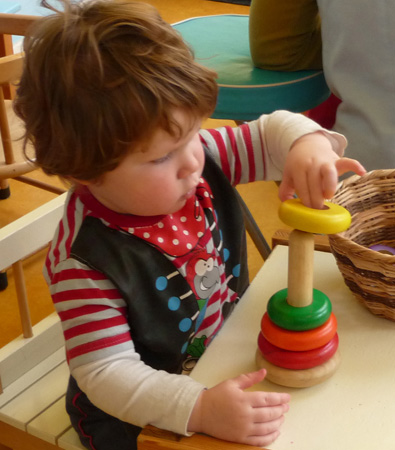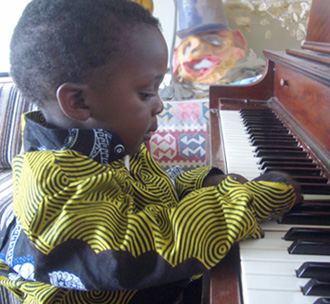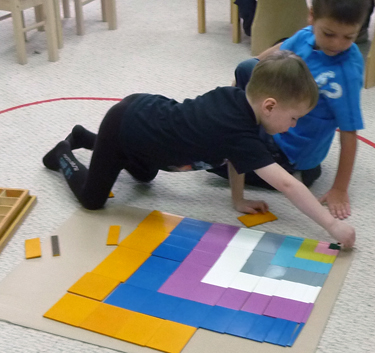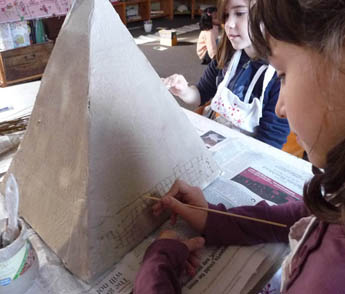Toys and books for Age 1-3, math and geometry (see below): 1-2 math
THE REAL WORLD FIRST
At this age the child is introduced to the world of math and geometry through manipulative toys and puzzles, real work such as the practical life activities, and the natural world of physics (sand and water) and other sciences. Laying the foundation for later math and geometry work.
It is not enough for the teacher to restrict herself to loving and understanding the child; she must first love and understand the universe.
—Maria Montessori, M.D.
An interest in and love for astronomy and geology, sand and water, and all of science begins early. The first lessons come from nature—experiences of the sun and wind, playing in sand and water and mud, seeing the sun rise and set, watching the stars at night, visiting the seashore, and the child’s own collections of rocks and minerals.
First we give the child the rocks, sand, water, mud, oceans, clouds, stars, lakes, and so forth; and then we give the names. All of this experience and knowledge leads to a natural concern and responsibility at a later age because children love what they know.
What is God? He is length, width, height and depth.
—St. Bernard of Clairvaux
TOYS AND PUZZLES
There are also many manipulative toys and puzzles that give the child practice in making comparisons, graduated sizes and shapes, all important preparation for math and geometry.
The foundation of a love of math comes not from rote lessons, but from joyful experience in seeing shapes and objects, in exploration with hands, and in moving through space.
The formation of the mathematical mind, which will last a lifetime, comes from early, simple, everyday activities —collecting, counting, sorting, putting things in order, classifying, comparing sizes and colors, carrying heavy objects by hand or in a wheelbarrow, setting the table, and discovering relationships and patterns through these activities.
In the past, mathematical relationships were wondrous miracles, and so they are still for the young child who is discovering them for the first time. It is a joy for the adult to stand back and observe these discoveries as the child makes them.
COUNTING REAL THINGS, NOT ROTE RECITATION
Reciting one, two, three, four, five, and so on, is fun for a child, but not nearly so exciting as discovering that these words stand for quantities of anything—buttons, peas, spoons, family members, stars in the sky—and the realization that these concepts are used and understood all over the world!
REAL WORK
And we should never underestimate the value of practical life work, real work with the brain and hand working together in building a strong foundation in math and geometry.
If men had used only speech to communicate their thought, if their wisdom had been expressed in words alone, no traces would remain of past generations. It is thanks to the hand, the companion of the mind, that civilization has arisen. The hand has been the organ of this great gift that we inherit.
—Montessori
Newsletters announcing books
#13 Book, Child of the World: Montessori, Global Education for Age 3-12+, March 2013
#14 Book, The Joyful Child: Montessori, Global Wisdom for Birth to Three, July 2013
#15 Book, The Universal Child, October 2013
#21 Book, No Checkmate, Montessori Chess Lessons for Age 3-90+ May 2016
#23 Book, Montessori and Mindfulness, November 2017
#25 Book, The Red Corolla, Montessori Cosmic Education (preparation in the 3-6 class), June 2019
#26 Book, Montessori Homeschooling, One Family's Story , August 2020
#27 Book, Aid to Life, Montessori Beyond the Classroom, March 2021
#28 Book, Please Help Me Do It Myself, Observation and Recordkeeping for the Montessori Primary and Elementary Class, May 2022
Other Newsletters of interest
#2 Montessori Art, Jan 2010
#3 Montessori Cultural Geography, May 2010
#4 Montessori Parenting/Teaching, Aug 2010
#5 Montessori Home Environment, Nov 2010
#6 Montessori in Sikkim, Jan 2011
#7 Montessori Math, Apr 2011
#8 All 2009-2011 Newsletters, May 2011
#9 Montessori Grace and Courtesy, Aug 2011
#10 Montessori Biology, May 2012
#11 Practical Life, Real Life, Aug 2012
#12 Happy Children for the Holidays, Dec 2012
#16 Montessori Language, Apr 2014
#17 Swaddling, Caring for Others, Authentic Montessori. Nov 2014
#18 Concentration, Where the Magic Happens!, May 2015
#19 Michael Olaf Montessori Company, Nov 2015
#20 Cosmic Education, Feb 2016 |
Toys and books for age 3-6, math and geometry: 3-6 math
ENJOYING MATH
I do not know when geometry and mathematics became a study I dreaded, but I know when I started enjoying it. My father loved math and enjoyed explaining the operation of the slide rule to me. He wanted very much to have someone in the family who shared this passion; there was no one. In school math was required, the multiplication tables were essential and painful, and some teachers hated teaching math as much as some students hated learning it.
Then, during my Montessori 3-6 training, I observed school where children chose math over everything else and worked on it for hours and hours, and where teachers loved teaching it! Later, in teaching Montessori 6-12 classes I saw the same thing with square root, cubing, and every kind of math and science. I learned, not to hide my prejudices, but to find the enjoyment in every subject. Only then could I hope to pass on a true love of learning to my students.
EXPERIENCE FIRST
The concepts of math and geometry as symbols on paper make sense after sensorial experience. Removed from real objects these studies become dry and meaningless. Children naturally have an interest in all aspects of mathematics, weight, order, systems, series, time, quantities and symbols, and so forth. We can serve the development of the mathematical mind by feeding this interest, giving sensorial experiences first, and only then their representatives on paper.
Sometimes people think there is something magic about sensorial math materials. Yes, the materials are certainly ingenious, but the real value of manipulatives is that they support the natural love of math concepts and activities that occurs early in life. These activities include: counting, sorting, classifying objects, experiences with series of sizes and colors, weighing and measuring, carrying out housework such as dish washing, with many sequential, logical steps—these are activities that nourish the mathematical mind.
MANIPULATIVE MATERIALS
When the first Casa dei Bambini in Rome was opened in the beginning of the 20th century the children were not taught math until they asked if they could study it. It was when the 3-6 children asked to use the math materials from the elementary classes and were more successful at learning these concepts (!) that math began to be an important part of Children’s Houses for children from the age of three to six.
Many people misunderstand, at first, what it means to learn math at this age. They remember how they learned the multiplication tables for example—tedious and boring, hours of painful repetition that was certainly not the first choice of activities.
In the 3-6 class, children love to learn the quantities and symbols for numbers in the thousands. They often learn addition, subtraction, multiplication and division with the decimal system and with fractions, simultaneously.
None of this work is required of the children, but it is offered, presented with manipulative materials to one child at a time—by the adult and sometimes another child. There are no teachers lecturing to a group of children who are required to sit still and listen. The children choose this work, and repeat each step with joy and enthusiasm until they are ready to move to the next step.
Certainly not every child masters or even works with every piece of math material in the 3-6 class. The main point is that an enjoyable and interesting introduction to all of the areas of geometry and math are present in the environment. The child is introduced to each activity as she is ready, and given the choice of whether or not to continue to work with it. In the meantime, she is surrounded by other children joyfully exploring math.
Math and geometry are presented and treated in the same way as art, building with blocks, music, gardening, and all other subjects. What a different and wonderful introduction to a subject detested and feared by many of us adults.
A child who is allowed to explore with real mathematical objects at an early, motor-sensorial age stands a good chance of becoming a real math lover later in life. If his passions lie elsewhere, at least he will be exempt from the math phobia that so many of us experience because of our own less-than-joyful introductions to this area of learning.
Math and geometry materials do not have to be expensive; they can be made of cardboard cubes, strings of beads, blocks, and beans, anything that helps the child grasp the concept through her senses.
In fact, the more one uses everyday objects for comparing, measuring, counting, and carrying out any other mathematical processes, the more math becomes a part of the real, practical, everyday life of the child. |
INVENTION, GEOMETRY AND MATH
Invention, geometry, and math, are languages used to explore and manipulate, to create and measure, real objects in a real world. At this age children continue to enjoy exploring math and geometry concepts if they are related to real life, and if they are presented with materials that can be handled, manipulated, used to create. We must keep sight of this fact when teaching children. We give manipulative materials in all areas of math and leave it to each child to decide when she is ready to work without materials—in the abstract—on paper with pencil.
This abstract work is a higher mental level of work, which comes naturally after the child has learned to picture the object being measured or related to other objects in her mind.
In the elementary class stories are told and experiments carried out to show children how humans used their imaginations in the past, and how they are using them today, to solve problems and come up with great inventions—the use of fire, measuring the earth, compasses, boats, and many others. They see how inventions, geometry and math came about as the result of human progress, to meet specific needs.
Geometry, for example, arose from the practical need to reestablish planting boundaries after the annual flooding of the Nile in Egypt. In “geometry,” “geo” stands for “earth,” and “metry” for “measure.”
The Hindus introduced the use of “0.” Let the child try to do math without it! Where did algebra, calculus, trigonometry come from? They want to know!
Children of this age love to reach back into history with their imaginations and reconstruct these needs and solutions and the creation of systems of learning. They are inspired by these stories, and by examples and pictures, to find out more. Children come to realize that mathematics has evolved and is still evolving from a practical need. Math, graphing, fractions, all become logical tools for recording and measuring, and algebra a short cut for recording.
We encourage children to make up their own problems —especially story problems related to their lives and the subjects they are studying—for themselves and for their friends, in order to come to a very practical and clear understanding of geometry and math. Children enjoy making up problems for each other, and examples that stump their teachers. This process of math concepts makes them stick in the child's mind.
With higher math, geometry and algebra, we give many practical examples and help the children come up with their own formulae after much experience. For example, if a child measures all of the rectangles in the room—tables, windows, books, etc. for figuring surface area, he will easily create, and even better understand, the formula "A=lw."
For each grade level, from 1st through high school, the children are shown the state requirements of math, just as any other subject. Then they learn to plan and schedule their work. It is left to each child to decide the best system and schedule, through trial and error, and with adult help, depending on learning styles, and interests. This teaches the math of planning, scheduling, allotting sufficient time, and it teaches responsibility.
When children are given this solid, material foundation, and see the relationship of geometry and math to the real world, it makes it easier for them, in later years, to spend long periods of time working on paper.
This is because they know that these steps are just that—steps which will take them to a new level of understanding in the exciting world of math and science.
It is the teacher's job to help each child master the required math and geometry work, to provide practice tests, and comparisons with the level of work of other students in other schools, cities, and states. Children given math in the Montessori way usually out pace their peers, but more importantly they develop a life long love of the subject.
These books speak to anyone wanting to understand Montessori. They are based on the author's fifty years of experience as a Montessori teacher and administrator, speaker, school consultant, and examiner for Montessori teacher training courses. Some have been translated in other languages, the English versions are available from Montessori book suppliers and online.
QUOTING BOOKS
Permission is granted to quote up to 500 words at any one time—on websites or school newsletters or social media—from any of these books, as long as a link back to the book is provided.
AUTHOR'S WEBSITE, Montessori work over the years, art and international blog, SUSAN
MICHAEL OLAF Montessori information MICHAEL OLAF
MICHAEL OLAF Montessori shop BOOKS & MATERIAL
This page was updated on May 10, 2022 |



